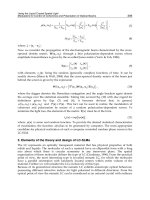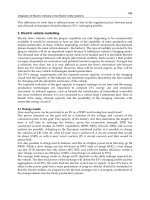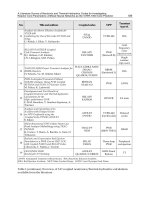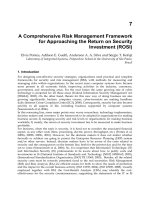Rubber Compounding - Chemistry and Applications Part 9 pptx
Bạn đang xem bản rút gọn của tài liệu. Xem và tải ngay bản đầy đủ của tài liệu tại đây (1.13 MB, 51 trang )
8
General Compounding
Harry G. Moneypenny
Moneypenny Tire & Rubber Consultants, Den Haag, The Netherlands
Karl-Hans Menting
Schill + Seilacher ‘‘Struktol’’ Aktiengesellschaft, Hamburg, Germany
F. Michael Gragg
ExxonMobil Lubricants & Petroleum Specialties Company, Fairfax,
Virginia, U.S.A.
I. INTRODUCTION
In conjunction with the chemicals used in a rubber formulation to ensure
acceptable product characteristics, a number of ingredients may be incorpo-
rated to allow or improve processing with the manufacturing equipment
available in the plant. The stages of rubber processing may be broken down
into raw materials handling, mixing, forming, and vulcanization. Some of the
factors that may influence the process economics and product acceptability in
these stages are listed in Table 1. The function of the processing additives is to
minimize or overcome any problems associated with product fabrication
while maintaining, or even improving, product performance. Before going
into detail, some examples of acceptable performance criteria for processing
additives at the four stages in product manufacture are presented briefly.
Note: Throughout this chapter the authors make reference to suppliers of particular materials
and their trade names. Mention of any company does not imply that it is the sole supplier of this
material.
4871-9_Rodgers_Ch08_R2_052404
MD: RODGERS, JOB: 03286, PAGE: 365
Copyright © 2004 by Taylor & Francis
Table 1 Rubber Processing—Performance Factors
Stage Operation Performance factors
Raw materials Storage, handling, 1. Temperature control
weighing, blending, 2. Humidity control
delivery 3. Handling of dusty and
hazardous materials
4. Automatic handling and
weighing
5. Weighing accuracy with
small quantities
6. Uniformity of blending
Mixing Internal mixer mill 1. Viscosity reduction in
2. Viscosity control
3. Heat generation
4. Filler incorporation
5. Filler dispersion
6. Hydrophobation
reaction with silica
7. Homogenization
8. Sticking and release
9. Mix time
Forming Extrusion, hot/cold feed 1. Flow
2. Sticking and releasecalendering, sheet/fabric
3. Shrinkage and stretchingcalendering, profile
4. Die swellcutting/joining fabric,
5. Dimensional stabilitybuilding
6. Tack
7. Green strength
8. Scorch
9. Surface appearance
10. Bloom
11. Fabric cord penetration
Vulcanization Compression molding, 1. Scorch
2. Flowtransfer molding,
3. Component state of cureinjection molding,
4. Curative migration and
dispersion
continuous vulcanization
5. Mold release, fouling,
cleaning
6. Surface appearance
Source: Schill+Seilacher, Hamburg, Germany.
4871-9_Rodgers_Ch08_R2_052404
MD: RODGERS, JOB: 03286, PAGE: 366
Copyright © 2004 by Taylor & Francis
A. Raw Materials Handling
Chemicals are frequently dusty powders that are difficult to handle and to
disperse. They can become electrostatically charged, and as a result incorpo-
ration into a product is made more difficult. Also, dusty powders are
undesirable for environmental reasons, and this has led to the use of binders
and dispersing agents to improve materials handling and weighing. Generally
preparations are coated, nondusting powders, granules, and masterbatches.
B. Mixing
During mixing in the internal mixer or open mill the additives should facilitate
homogeneous blending of different polymers and enable faster incorporation
of fillers and other compounding materials. Mixing should be optimized with
respect to time, temperature, and energy. Compound viscosity should be
reduced only to that level which allows acceptable processing in the ongoing
manufacturing stages. Uniform distribution and optimum dispersion of all
compounding materials should be achieved, and the influence on scorch time
has to be minimal and/or controllable. If possible, the tackiness of the com-
pound should be controlled. Both excessive sticking to the machines and
bagging on the mill due to a lack of stickiness must be avoided.
C. Forming
Down-line processing, i.e., shaping of semiproducts, requires compounds
with good flow properties. Profile compounds should calender and extrude
easily, fast, and uniformly. The profiles should exhibit dimensional stability,
smooth surface appearance, and exact edge definition. Temperature and die
swell or shrinkage should be controllable and acceptable. For sheet calen-
dering, a smooth surface, uniform shrinkage, and freedom from blisters are
required. For metal wire or textile calendering, cutting, and joining, good flow
properties and acceptable tack are required. Last but not least, bloom should
be avoided.
D. Vulcanization
In the vulcanization process good flow properties are needed in order to
1. Obtain adequate compound–compound adhesion
2. Obtain compound–metal and/or compound–textile adhesion
3. Fill the mold quickly, uniformly, and free of blisters or trapped air,
particularly with transfer and injection molding equipment.
4871-9_Rodgers_Ch08_R2_052404
MD: RODGERS, JOB: 03286, PAGE: 367
Copyright © 2004 by Taylor & Francis
Finally, the vulcanizates should demold easily without tear and not produce
mold-fouling residues.
Processing additives may be subdivided according to their chemical
structures (Table 2), or according to their application (Table 3). Several
classes of substances can have more than one application. For example, fatty
acid esters act as lubricants and dispersing agents. Mineral oils act as physical
lubricants in rubber compounds, reducing viscosity, and also help in the filler
dispersion process. In this chapter we discuss the following compounding
ingredients with respect to their influence on processing behavior and their
relevant compound vulcanizate properties:
Physical and chemical peptizers
Lubricants
Homogenizing agents
Dispersing agents
Tackifiers
Plasticizers
Masterbatches—i.e. sulfur, accelerator, etc.
Mineral oils
II. PHYSICAL AND CHEMICAL PEPTIZERS
A. Mastication
Mastication is the process whereby the average molecular weight of a polymer
is reduced by mechanical work. The resulting lower viscosity of the polymer
Table 2 Processing Additives—Chemical Structure
Group Examples
Mainly hydrocarbons Mineral oils
Paraffin waxes
Petroleum resins
Fatty acid derivatives Fatty acids
Fatty acid esters
Fatty alcohols
Metal soaps
Fatty acid amides
Synthetic resins Phenolic resins
Low M.W. polymers Polyethylenes
Polybutenes
Organothio compounds Peptizers
Source: Schill+Seilacher, Hamburg, Germany.
4871-9_Rodgers_Ch08_R2_052404
MD: RODGERS, JOB: 03286, PAGE: 368
Copyright © 2004 by Taylor & Francis
facilitates the incorporation of fillers and other compounding ingredients and
can improve their dispersion. Because it is often difficult to homogeneously
blend rubbers with very different viscosities, mastication of the higher vis-
cosity rubber will enable improved blending with other, lower viscosity elas-
tomers. Improved compound flow leads to easier down-line processing such
as calendering and extrusion. Shorter processing time and lower power con-
sumption are generally obtained.
Table 3 Processing Additives—Applications
Processing aid Application Examples
Chemical peptizer Reduces polymer viscosity
by chain scission
2,2V -Dibenzamidodiphenyl-
disulfide
Pentachlorothiophenol
Physical peptizer Reduces polymer viscosity
by internal lubrication
Zinc soaps
Dispersing agent Improves filler dispersion Mineral oils
Reduces mixing time Fatty acid esters
Reduces mixing energy Metal soaps
Fatty alcohols
Lubrication agent Improves compound flow
and release
Mineral oils
Metal soaps
Fatty acid esters
Fatty acid amides
Fatty acids
Homogenizing
agent
Improves polymer blend
compatibility
Improves compound
uniformity
Resin blends
Tackifier Improves green tack Hydrocarbon resins
Phenolic resins
Plasticizer Improves product
performance at low
and high temperatures
Aromatic di- and triesters
Aliphatic diesters
Alkyl and alkylether monoesters
Stiffening agent Increases hardness High styrene resin rubber
Masterbatches
Phenolic resins
Trans-Polyoctenamer
Softening agent Lowers hardness Mineral oils
Mold release
agent
Eases product release
from mold
Decreases mold
contamination
Organosilicones
Fatty acid esters
Metal soaps
Fatty acid amides
Source: Schill+Seilacher, Hamburg, Germany.
4871-9_Rodgers_Ch08_R2_052404
MD: RODGERS, JOB: 03286, PAGE: 369
Copyright © 2004 by Taylor & Francis
Because most of today’s synthetic rubbers are supplied with easy-to-
process viscosity levels, the mastication process is mainly restricted to natural
rubber.
Although the natural rubber mastication process may be accomplished
on an open mill, it is generally carried out in an internal mixer. During
mechanical breakdown the long-chain rubber molecules are broken under the
influence of high shear from the mixing equipment. Chain fragments with
terminal free radicals are formed, which recombine to form long-chain
molecules if they are not stabilized (Fig. 1). Through atmospheric oxygen
the radicals are saturated and stabilized. The chains are shorter, the molecular
weight is reduced, and the viscosity drops. The course of the chain breakdown
of natural rubber is shown in Figures 2 and 3.
Temperature is an important factor in the mastication of natural
rubber. When the breakdown of natural rubber is plotted versus temperature
(Fig. 4), it can be seen that the effect is lowest in the range of 100–130jC.
Chain cleavage by the mechanical process is more efficient at low temper-
Figure 1 Physical peptization of rubber. (Courtesy of Schill+Seilacher.)
Figure 2 Physical peptization of rubber—reaction sequence. (Courtesy of
Schill+Seilacher.)
4871-9_Rodgers_Ch08_R2_052404
MD: RODGERS, JOB: 03286, PAGE: 370
Copyright © 2004 by Taylor & Francis
atures (below 90jC) because, owing to the viscoelastic nature of elastomers,
the shear is higher the lower the temperature. With increasing temperature
the mobility of the polymer chains increases; they slide over one another,
and the energy input and generated shear force drop. However, although the
mechanical breakdown process is minimal around 120jC, above this temper-
ature another breakdown process with a different mechanism, thermo-
oxidative scission of the polymer chains, takes over and becomes more severe
as temperature increases. An envelope curve is formed by the curves of the
thermomechanical mastication and thermo-oxidative breakdown at elevated
temperatures. In practice, the two reaction modes superimpose. Whereas the
mechanical breakdown at low temperatures largely depends on the mixing
parameters, the thermo-oxidative breakdown is accelerated by temperature
and catalysts, i.e., peptizing agents.
Free radicals are generated when the molecular chains of the rubber are
broken by mechanical or thermo-oxidative means. These radicals may re-
Figure 3 Physical peptization of polyisoprene. (Courtesy of Schill+Seilacher.)
Figure 4 Peptization of NR. Viscosity reduction vs. temperature. (Courtesy of
Schill+Seilacher.)
4871-9_Rodgers_Ch08_R2_052404
MD: RODGERS, JOB: 03286, PAGE: 371
Copyright © 2004 by Taylor & Francis
combine, and consequently no reduction in molecular weight and viscosity
will be observed. Moreover, branching is likely to occur. The peptizing agents
can act as radical acceptors, thus preventing recombination of the generated
chain-end free radicals.
All peptizing agents shift the start of thermo-oxidative breakdown to
lower temperatures. Of the peptizing agents used in former times (Fig. 5), only
combinations of specific activators with thiophenols, aromatic disulfides, and
mixtures of the activators with fatty acid salts are now available. Note that for
environmental reasons the chlorine-containing or polychlorinated thiophe-
nols have largely been removed from use.
The activators used in combination with a peptizing agent permit
breakdown to start at lower temperatures and accelerate the thermo-oxida-
tive process. They are chelates—complexes of ketoxime, phthalocyanine, or
acetylacetone with metals such as iron, cobalt, nickel, or copper, but now-
adays almost exclusively iron complexes. These chelates facilitate the oxygen
transfer by formation of unstable coordination complexes between the metal
atom and the oxygen molecule. This loosens the OUO bond, and the oxygen
becomes more reactive. Because of the high effectiveness of the activators or
boosters they are used only in small proportions in the peptizing agents.
During recent times physical peptizers have gained major importance.
They act as internal lubricants and reduce viscosity without breaking the
Figure 5 Common peptizing agents. (Courtesy of Schill+Seilacher.)
4871-9_Rodgers_Ch08_R2_052404
MD: RODGERS, JOB: 03286, PAGE: 372
Copyright © 2004 by Taylor & Francis
polymer chains. Generally, zinc soaps have proved to be very effective in this
role. Mechanical and chemical breakdown of the elastomer results in chain
scission, lower molecular weight, broader molecular weight distribution, and
an increased number of free chain ends. Normally this leads to an increase in
compound heat buildup and a decrease in abrasion resistance. Lubricants do
not change the molecular chains, i.e., the chains are not broken.
As mentioned previously, synthetic rubbers are normally supplied with
easy-to-process viscosity levels. If viscosity reduction is needed, mechanical
mastication in an internal mixer has virtually no effect. In comparison to
natural rubber, viscosity reduction of synthetic rubbers is more difficult owing
to the 1) lower number of double bonds (SBR, NBR); 2) electron-attracting
groups in the chain, which stabilize the double bonds; 3) vinyl side groups,
which foster cyclization at high temperatures (NBR, SBR, CR); and 4) lower
green strength due to the absence of strain-induced crystallization (NBR,
SBR).
Synthetic rubbers can be broken down by means of peptizing agents.
However, they require higher dosage levels and temperatures than natural
rubber. For this reason they are nowadays mostly physically peptized with
salts of unsaturated fatty acids.
B. Processing with Peptizing Agents
At one time it was common practice to have a separate mastication stage
whereby the peptizer was added to the NR and the mixing cycle was con-
trolled to obtain an acceptable viscosity reduction. Nowadays normally only
one stage is used, with the filler addition being delayed in order to allow the
peptizing agent to be incorporated in the rubber. The early addition of the
filler, while enhancing shearing and breakdown, also has a positive effect
on dispersion. However, as the activators used in combination with the pep-
tizing agent may be adsorbed by the filler, it is normal to increase loading
slightly.
When natural rubber is blended with synthetic rubber that has a lower
viscosity, it is useful to peptize the natural rubber before the synthetic rubber
is added.
Because antioxidants inhibit the oxidative breakdown of rubber, they
should be added late in the mixing cycle during the processing of natural
rubber. With synthetic rubbers an early antioxidant addition can avoid
cyclization.
Figure 6 shows the influence of a number of chemical and physical
peptizing agents on the breakdown, as measured by Mooney viscosity, of
natural rubber (RSS1) in a 1 L laboratory internal mixer at 65 and 49 rpm and
a start temperature of 90jC. Samples for Mooney viscosity testing were taken
after 6, 9, 12, and 15 min.
4871-9_Rodgers_Ch08_R2_052404
MD: RODGERS, JOB: 03286, PAGE: 373
Copyright © 2004 by Taylor & Francis
Comparable results are obtained when physical peptizers are used at
higher dosage levels than the chemical peptizers. The raw RSS1 had a
Mooney viscosity of 104.
C. Influence of Peptizing Agents on Vulcanizate Properties
The effects of a chemical peptizer (STRUKTOLR* A 86, an aromatic di-
sulfide in combination with a metal organic activator), a physical peptizer
(STRUKTOLR A 60, based on unsaturated fatty acid salts of zinc), and
mechanical mastication on viscosity reduction and the tensile properties of
NR (SIR 5 L) have been investigated. Apart from the usual evaluation of
viscosity at low shear rates (i.e., Mooney viscosity, ML 1 + 4V, 100jC), vis-
cosity at higher shear rates, using a rubber processing analyzer (RPA), was
measured. The data are shown in Table 4.
Under low shear conditions the chemical peptizer is by far the more
effective method for viscosity reduction. However, under higher shear, which
Figure 6 Chemical vs. physical peptizers in NR. STRUKTOLR A 82 is a chemical
peptizer containing an organic metal complex booster. STRUKTOLR A 86 combines
a chemical peptizer and a booster. Its composition is similar to that of STRUKTOLR
A 82 but with a higher concentration of active substance. STRUKTOLR A50P
contains zinc soaps of high molecular weight fatty acids. STRUKTOLR A 60 is similar
to STRUKTOLR A 50 P but has a lower melting range, allowing open mill mixing.
(Courtesy of Schill+Seilacher.)
* STRUKTOL is a registered trademark of Schill+Seilacher ‘‘ Struktol’’ AG, Hamburg,
Germany.
4871-9_Rodgers_Ch08_R2_052404
MD: RODGERS, JOB: 03286, PAGE: 374
Copyright © 2004 by Taylor & Francis
is a better simulation of factory conditions, the physical peptizer performs
better. This is of special importance because there are sometimes concerns
with the use of chemical peptizers regarding their effect on long-term physical
properties of compounds. The changes in modulus and tensile strength
(Table 5) show a greater degradation of natural rubber with the chemical
peptizer system, whereas the physical peptizer highlights better retention of
physical properties.
Chemical peptizers give the greatest fall in rubber viscosity, but they
cause an increase in the amount of very low molecular weight polymer. They
also adversely affect dynamic heat buildup, increasing tan delta in comparison
with mechanical mastication, especially on overcure and aging. Similar
rubber viscosities can be achieved by masticating the rubber in the presence
of fatty acid soaps without a significant change in tan delta (1).
In summary, the benefits of peptizing agents are as follows. They
Accelerate viscosity reduction, decreasing mixing time
Reduce power consumption
Promote batch-to-batch uniformity
Facilitate blending of elastomers
Table 4 Influence of Chemical and Physical Peptizers on Viscosity Reduction
Mechanical
mastication
Chemical
peptizer
Physical
peptizer
ML (1+4V), 100jC94 65 83
Shear stress (sec
À1
) Viscosity (Pa-sec)
55.3 5.017 5.536 4.325
99.7 3.125 3.125 2.626
299.1 1.344 1.329 1.113
Source: Schill+Seilacher, Hamburg, Germany.
Table 5 Influence of Chemical and Physical Peptizers on Tensile Properties
Mechanical
mastication
Chemical
peptizer
Physical
Peptizer
Cure at 150jC (min) 40 120 40 120 40 120
300% Modulus (MPa) 13.1 12.1 14.4 13.1 14.6 14.1
Tensile strength (MPa) 26.1 24.4 25.8 22.1 26.8 25.6
Source: Schill+Seilacher, Hamburg, Germany.
4871-9_Rodgers_Ch08_R2_052404
MD: RODGERS, JOB: 03286, PAGE: 375
Copyright © 2004 by Taylor & Francis
Reduce mixing costs
Improve dispersion
III. LUBRICANTS
A. General Discussion
Lubricants are processing additives that are used to improve compound flow
and release. In the early days of rubber processing it was recognized that
stearic acid, zinc stearate, and wool grease were effective in improving the
flowability of rubber compounds. Barium, calcium, and lead stearate were
used but were withdrawn some time ago for environmental reasons. The
essential raw materials for this class of products are fatty acids, fatty acid
salts, fatty acid esters, fatty acid amides, and fatty alcohols. In addition,
hydrocarbons such as paraffin wax are of importance. More recently, low
molecular weight polyethylene and polypropylene have been used because of
their waxlike character.
Modern lubricants on the market are normally composed of the above-
listed basic materials. Among the fatty acids, stearic acid still finds widespread
application as a material that improves both the processability of compounds
and their curing characteristics. Because of their low melting point and
waxlike character, fatty acids enhance both mixing and down-line processing.
They reduce the stickiness of compounds. The fatty acids produced from
vegetable oils and animal fats are predominantly mixtures of C
16
–C
18
fatty
acids. Even though they have a higher volatility, fatty acids having a shorter
chain length, such as lauric acid (C
12
), are occasionally used.
The limited compatibility of stearic acid with synthetic rubbers and the
need for specialty products to solve complex processing problems have been
the driving force for the development of more modern lubricants. Raw
materials for most lubricants are mixtures of glycerides such as vegetable oils
and animal fats. Typical examples are listed in Table 6. Through saponifica-
tion of the glycerides, mixtures of fatty acids are obtained that vary in carbon
chain length distribution and in their degree of unsaturation.
The most important fatty acids are listed in Table 7. Separation and
purification processes lead to specified technical grade fatty acids that are the
basis for tailor-made lubricants in rubber processing.
The fatty acids tend to be incompatible and therefore insoluble in the
rubber hydrocarbon, and consequently they can migrate to the surface of the
uncured rubber to form a bloom. This will be detrimental to the tack-building
ability of the component and may lead to down-line assembly problems. This
has led to the development of fatty acid esters, fatty acid amides, and metal
soaps that are soluble in rubber and minimize bloom formation.
4871-9_Rodgers_Ch08_R2_052404
MD: RODGERS, JOB: 03286, PAGE: 376
Copyright © 2004 by Taylor & Francis
Fatty acid esters are produced through reaction of fatty acids with
various alcohols. Apart from good lubricating effects they promote the
wetting and dispersion of compounding materials. The carbon chain lengths
of the acid and alcohol components vary between C
16
and C
34
.
Metal soaps are produced through the reaction of water-soluble fatty
acid salts with metal salts (e.g., ZnCl
2
) in an aqueous solution (precipitation
process). Metal soaps are also obtained via a direct reaction of fatty acid with
metal oxide, hydroxide, or carbonate.
The most important metal soaps are zinc and calcium soaps, with the
zinc soaps having the largest market share. Because calcium soaps have less
influence on the cross-linking reaction and scorch time, in most cases they are
used in compounds based on halogen-containing elastomers such as CR or
Table 7 Important Fatty Acids
Fatty acid Chain length
a
Double bonds
Palmitic 16 0
Stearic 18 0
Oleic 18 1
Erucic 22 1
Ricinoleic
b
18 1
Linoleic 18 2
Linolenic 18 3
a
Number of C atoms.
b
12-Hydroxyoleic acid.
Source: Schill+Seilacher, Hamburg, Germany.
Table 6 Important Raw Materials for
Fatty Acids
Castor oil Cotton oil
Coconut oil Groundnut oil
Herring oil Linseed oil
Olive oil Palm oil
Palm kernel oil Rapeseed oil
Soybean oil Sunflower oil
Tallow
Source: Schill+Seilacher, Hamburg, Germany.
4871-9_Rodgers_Ch08_R2_052404
MD: RODGERS, JOB: 03286, PAGE: 377
Copyright © 2004 by Taylor & Francis
halobutyl. The metal soaps are mostly based on C
16
–C
18
fatty acids. Because
of better solubility in the rubber and lower melting points, modern lubricants
frequently contain the salts of unsaturated fatty acids.
When 2–5 phr of a metal soap is present in a compound, the stearic acid
level should be reduced to 1 phr to minimize bloom.
The most well known soap, zinc stearate, is also used as a dusting agent
for uncured slabs based on nonpolar rubbers. Owing to its high crystallinity
the compatibility of zinc stearate is often limited. Bloom can occur, which
may lead to ply separation in assembled articles.
In general metal soaps are also good wetting agents. Under the influence
of higher shear rates they promote compound flow, but without shear the
viscosity remains high (green strength). As discussed in the previous section,
soaps of unsaturated fatty acids are also used as physical peptizers because of
their lubricating effect; they exhibit high compatibility with rubber.
Mixtures of zinc salts based on aliphatic and aromatic carboxylic acids
are cure activators, strongly delaying the reversion of NR compounds. The
effect is most pronounced in semi-EV systems.
Fatty alcohols are obtained through reduction of fatty acids. Straight
fatty alcohols are rarely used as processing additives for rubber compounds
because of their very limited solubility. They act as internal lubricants and
reduce the viscosity.
Fatty acid amides are reaction products of fatty acids or their esters with
ammonia or amines. All products of this group reduce scorch safety, which
needs to be allowed for in compound development.
Organosilicones are relatively new in the range of lubricants. They are
produced through condensation of fatty acid derivatives with silicones and
combine good compatibility through the organic component with the excel-
lent lubricating and release properties of the silicones. Depending on their
structure they can be adapted to standard or specialty elastomers. They have
high thermal stability. Because of their high compatibility the organosilicones
are not prone to reduced adhesion, delamination, or general contamination,
which are generally associated with the presence of silicones in a rubber
factory. They significantly improve calendering and demolding and reduce
mold fouling in critical polymers such as ethylene oxide epichlorohydrin
copolymer (ECO) or fluoropolymers such as FKM.
Polyethylene and polypropylene waxes of low molecular weight are
easily dispersed in natural rubber and synthetic rubbers. They act as lubri-
cants and release agents. They improve the extrusion and calendering of dry
compounds in particular and reduce the stickiness of low viscosity com-
pounds. Their compatibility with polar rubbers such as polychloroprene or
acrylonitrile butadiene copolymer (NBR) is limited. This can lead to adhesion
and knitting problems when higher dosage levels are used.
4871-9_Rodgers_Ch08_R2_052404
MD: RODGERS, JOB: 03286, PAGE: 378
Copyright © 2004 by Taylor & Francis
B. Properties and Mode of Action of Lubricants
The major positive effects that can be achieved in various processing stages by
using lubricants are listed in Table 8.
A strict classification of the products into internal and external lubri-
cants is difficult, because practically all lubricants for rubber compounds
combine internal and external lubricating effects. This depends not only on
their chemical structure but also on the specific polymer in which they are
used. In general, the solubility in the elastomer is the determining factor.
A processing additive predominantly acting as an internal lubricant will
serve mainly as a bulk viscosity modifier and improve filler dispersion. Slip
performance is influenced only to a minor extent. A lubricant with predom-
inantly external action will greatly improve slip and reduce friction between
the elastomer and the metal surfaces of the processing equipment. Its
influence on compound viscosity is marginal. Filler dispersion can be
improved through accumulation at the interface between elastomer and filler.
Higher dosage levels, however, can lead to ‘‘overlubrication’’ (overconcen-
tration) and subsequent blooming.
Lubrication is achieved through a reduction of friction. In the initial
phase of addition the lubricant is coating the elastomer and possibly other
compounding materials, and friction against the metal parts of the processing
equipment is reduced. With increasing temperature the lubricant begins to
melt and is worked into the matrix by the shearing action of the mixer. The
rate and extent of incorporation of the lubricant into an elastomer is
Table 8 Lubricants—Processing Benefits
Process step Benefit
Mixing Faster filler incorporation
Better dispersion
Lower dump temperature
Reduced viscosity
Improved release
Processing Faster and easier calendering and extrusion
Improved release
Less energy consumption
Molding Faster cavity fill at lower operating pressure
Reduced stress in molded parts through easy cavity fill
Shorter cycle times
Improved release
Source: Schill+Seilacher, Hamburg, Germany.
4871-9_Rodgers_Ch08_R2_052404
MD: RODGERS, JOB: 03286, PAGE: 379
Copyright © 2004 by Taylor & Francis
determined by its melting point, melt viscosity, and solubility. These factors
depend on its chemical structure and polarity.
The chemical criteria for the efficiency of organic lubricants are the
length of the hydrocarbon chain, the degree of branching, the unsaturation,
and the structure and polarity of the terminal groups. The action of fatty acid
based lubricants has been explained by means of the micelle theory of
surfactant chemistry (2).
Rubber may be considered to be mostly nonpolar and as such is similar
to a mineral oil but with far higher molecular weight. When dispersed in this
medium, metal soaps that have a sufficiently long hydrocarbon chain can
form spherical or lamellar micelles. The nonpolar hydrocarbon chain of the
soaps is soluble in the rubber whereas the polar terminal group remains
insoluble. Because of their limited solubility the micelles can aggregate in
stacks (Fig. 7). Under the influence of the high shear rates that occur during
rubber processing, these layered aggregates can be shifted against one
another, and the rubber compound flows more easily (Fig. 8).
Relatively strong cohesion of the aggregates formed by zinc stearate can
be noted through a slight increase in the green strength of NR compounds
that contain this metal soap at higher concentrations.
The structure related effect of fatty acid based lubricants is shown in
Tables 9 and 10.
The polar groups of certain fatty acids and their derivatives exhibit a
high affinity to metal surfaces and are adsorbed easily. A film is formed at the
metal surface. The film is extremely thin, is quite stable, and withstands
relatively high shear. The formation of a film should in theory facilitate
demolding, and the high thermal stability of the lubricant should reduce mold
Figure 7 Metal soaps as surfactants in a polymer matrix. (Courtesy of Schill+
Seilacher.)
4871-9_Rodgers_Ch08_R2_052404
MD: RODGERS, JOB: 03286, PAGE: 380
Copyright © 2004 by Taylor & Francis
contamination. This is not, however, always the case in practice. Because
limited compatibility is the essential and determining factor for the effective-
ness of external lubricants, an overdosage has to be avoided, otherwise
undesirable bloom will occur. The lubricant concentration required, under
practical conditions, depends on the processing procedures used and in
particular on other compounding materials included in the formulation and
their individual dosage levels. Therefore it is necessary to check the compat-
Table 9 Structure–Property Relationships of Zinc Soaps
Structure Property
Carbon chain length
Below C
10
Unable to form effective micelles
Above C
10
Acts as surfactant
Carbon chain length distribution (blend)
Narrow Highly crystalline
Higher M.P.
Poor dispersibility
Can bloom easily
Broad Amorphous
Lower M.P.
Disperses readily
Reduced bloom tendency
Solubility is increased
Polarity
High (functional groups, metal salts) Increased affinity to metal surfaces
More surface-active
Low Acts internally
Less blooming
Branching Disrupts crystallinity
Totally soluble
Nonblooming
Source: Schill+Seilacher, Hamburg, Germany.
Figure 8 Metal soaps as rheological additives. (Courtesy of Schill+Seilacher.)
4871-9_Rodgers_Ch08_R2_052404
MD: RODGERS, JOB: 03286, PAGE: 381
Copyright © 2004 by Taylor & Francis
ibility of the lubricant chosen for a specific formulation. Additives are easily
adsorbed by fillers. Therefore higher dosages are required when highly active
fillers or high filler loadings are used. Certain plasticizers can reduce com-
patibility and make the additives bloom.
Many commercial zinc soaps are indeterminate blends resulting from
the ‘‘cut’’ of natural fatty acids used in the manufacture.
C. Processing with Lubricants
Most lubricants are easily incorporated. In some cases they are added at the
beginning of the mixing cycle, along with the fillers, to make use of their
dispersing effects. Many of them can also be added at the end of the cycle.
Because of their relatively low melting points the products will soften early
and give a good and uniform dispersion.
When the lubricating effect is of major importance, the processing
additives should be incorporated in the final stage. The effects of selected
lubricants on spiral mold cavity fill when they are added in the first pass or
final stage are shown in Figure 9.
Depending on requirements and compatibility, the dosage varies be-
tween 1 and 5 phr. Usually the minimum dosage is 2 phr. For an exceptionally
high lubricating effect in tacky compounds or where high extrusion rates and
easy demolding are critical, even higher dosages might be useful. This applies
also to compounds with high filler loadings.
D. Influence of Lubricants on Vulcanizate Properties
The effects of the lubricants STRUKTOLR WB 16 and STRUKTOLR A50
P on the physical properties of a natural rubber compound are shown in
Table 11. The lubricants lead to a decrease in 300% modulus in conjunction
with a small drop in tensile strength and increase in elongation to break. No
difference is observed in Shore hardness, but compression set increases
slightly (3).
Table 10 Structure–Property Considerations of Zinc Soaps
Most zinc soaps are rubber-soluble, therefore act as intermolecular lubricants.
Increased hydrocarbon chain length improves surfactant action.
Presence of unsaturation improves dispersibility.
Source: Schill+Seilacher, Hamburg, Germany.
4871-9_Rodgers_Ch08_R2_052404
MD: RODGERS, JOB: 03286, PAGE: 382
Copyright © 2004 by Taylor & Francis
Figure 9 Spiral mold cavity fill with lubricant-added in first or final stage. Struktol
WB 222 is an ester of saturated fatty acids. It is a lubricant and release agent
predominantly used for polar elastomers. STRUKTOLR WB 16 is a mixture of
calcium soaps and amides used as a lubricant for nonpolar polymers. STRUKTOLR
A 50 P is a zinc soap of unsaturated fatty acids. It is used as a physical peptizer in
NR compounds. (Courtesy of Schill+Seilacher.)
Table 11 Influence of Lubricants on NR Physical Properties
Property Control
STRUKTOLR
WB 16
STRUKTOLR
A50P
Cure at 150jC (min) 10 9 12
300% Modulus (MPa) 13.6 10.7 10.3
Tensile strength (MPa) 19.1 18.3 18.4
Elongation at break (MPa) 430 480 480
Shore A hardness 60 60 60
Compression set, 22 hr at 70jC (%) 21 24 24
Source: Schill+Seilacher, Hamburg, Germany.
4871-9_Rodgers_Ch08_R2_052404
MD: RODGERS, JOB: 03286, PAGE: 383
Copyright © 2004 by Taylor & Francis
IV. HOMOGENIZING AGENTS
A. Examples and Function
Homogenizing agents are used to improve the homogeneity of difficult-to-
blend elastomers. They assist in the incorporation of other compounding
materials, and intrabatch and batch-to-batch viscosity variation are reduced
by their use.
They are resin-based mixtures that exhibit good compatibility with
various elastomers and facilitate blending through early softening and
wetting of the polymer interfaces. Because the softening resins exhibit a
certain tackiness, polymers that tend to crumble and polymer blends will
coalesce more easily, energy input is maintained at a high level, i.e., mixing is
more effective, and mixing times can often be reduced.
Fillers are incorporated at a faster rate and are more evenly distributed
owing to the wetting properties of the homogenizing agents. Filler agglom-
eration is minimized.
Apart from their compacting effects the homogenizers lead to increased
green strength when used as a partial replacement for processing oil, and
compound flow is facilitated through improved homogeneity and a certain
softening effect. They increase the green tack of many compounds and boost
the efficiency of tackifying agents.
In summary, homogenizing agents promote 1) the blending of elas-
tomers; 2) batch-to-batch uniformity; 3) filler incorporation and dispersion;
4) shortening of mixing cycles; 5) energy savings; and 6) the building of
tack.
The greater the difference in the solubility parameter and/or viscosity of
each component elastomer in a blend, the more difficult it is to produce a
homogeneous mix (Table 12). Blends of plasticizers that are each compatible
with different elastomers can in theory be effective at improving blend
homogeneity, provided that they have a viscosity sufficiently high to maintain
high shear on mixing. Plasticizers have the disadvantage of being prone to
migration and bloom. Therefore mixtures of high molecular weight products
such as resins are more often used.
The homogenizing resins are themselves complex blends and contain
parts that are compatible with aliphatic and aromatic structures in a blend.
Potential raw materials for use as homogenizing resins can be divided into
three groups:
1. Hydrocarbon resins including coumarone-indene resins, petro-
leum resins, terpene resins, bitumens, tar, and copolymers, e.g.,
high styrene reinforcement polymers
2. Rosins and their salts, esters, and other derivatives
4871-9_Rodgers_Ch08_R2_052404
MD: RODGERS, JOB: 03286, PAGE: 384
Copyright © 2004 by Taylor & Francis
3. Phenolic resins of various kinds, such as alkylphenol-formalde-
hyde resins, alkylphenol and acetylene condensation products, and
lignin and modifications thereof
Coumarone resins, produced from coal tar, were the first synthetic
resins used as processing additives because of their ability to act as dispersing
agents to improve filler incorporation and as tackifiers. They are typical aro-
matic polymers, consisting mainly of polyindene. The structural elements of
these copolymers are methylindene, coumarone, methylcoumarone, styrene,
and methylstyrene (Fig. 10). The melting range of these products is between
35jC and 170jC.
Petroleum resins are relatively inexpensive products that are often used
at fairly high dosages, up to 10 phr or more. They are polymers produced from
the C
5
cut of highly cracked mineral oils. The petroleum resins are relatively
saturated and are also available with a high content of aromatic structures.
Grades with a lower content of aromatic compounds have a stronger
plasticizing effect. The highly saturated grades are used by the paint industry.
Apart from cyclopentadiene, dicyclopentadiene and its methyl derivatives,
styrene, methylstyrene, indene, methylindene, and higher homologs of iso-
prene and piperylene are found in these resins. This may explain their high
compatibility with different elastomers.
Table 12 Solubility Parameters of Elastomers and Plasticizers
Solubility parameter Elastomer Plasticizer
AU, EU
11
NBR (high nitrile) Polar ethers
Highly polar esters
NBR (medium nitrile)
NBR (low nitrile)
Low polar esters
CR
10 Aromatic
SBR
NR
BR Naphthenic
IIR
EPDM Paraffinic
9
EPM
Source: Schill+Seilacher, Hamburg, Germany.
4871-9_Rodgers_Ch08_R2_052404
MD: RODGERS, JOB: 03286, PAGE: 385
Copyright © 2004 by Taylor & Francis
Copolymers such as high styrene resin masterbatches are used for high
hardness compounds. Whereas straight polystyrene can hardly be processed
in rubber compounds, copolymers of styrene and butadiene with higher
styrene contents have proven their worth.
Terpene resins are very compatible with rubber and give high tackiness.
However, they are used mainly for adhesives. The polymers are based on a-
and h-pinene. The cyclobutane ring is opened during polymerization and
polyalkylated compounds are formed (Fig. 11). Terpene resins improve aging
performance and resistance against oxidation of rubbers.
Asphalt and bitumen are products that have been used since the very
beginning of rubber processing. Their tackifying effect is not very distinct.
Figure 11 Terpene resins—main constituents. (Courtesy of Schill+Seilacher.)
Figure 10 Coumarone resins—structural members. (Courtesy of Schill+Seilacher.)
4871-9_Rodgers_Ch08_R2_052404
MD: RODGERS, JOB: 03286, PAGE: 386
Copyright © 2004 by Taylor & Francis
They are relatively inexpensive products. Whereas asphalt is a naturally oc-
curring product, bitumen is produced from the residues of mineral oil pro-
duction. Blown bitumen, oxidized to achieve higher solidification points, is
also known as mineral rubber and is a good processing additive, for example,
in difficult-to-process compounds that have a high percentage of polybuta-
diene. Mineral rubber is also successfully used to improve the collapse
resistance of extrusions.
Rosins are natural products obtained from pine trees. They are
mixtures of organic substances, for the most part doubly unsaturated acids,
such as abietic acid, pimaric acid, and their derivatives (Fig. 12). To reduce
their sensitivity to oxidation, resins are partially hydrogenated or
disproportionated. Because of their acidity they have a slight retarding effect
on vulcanization. Abrasion resistance, in particular that of SBR, is said to be
Figure 12 Rosin acids. (Courtesy of Schill+Seilacher.)
4871-9_Rodgers_Ch08_R2_052404
MD: RODGERS, JOB: 03286, PAGE: 387
Copyright © 2004 by Taylor & Francis
improved. Rosin acid is widely used (as a salt) in the production of synthetic
rubbers (SBR) because of its emulsifying properties.
Phenolic resins (Fig. 13) are used mainly as tackifiers, reinforcing resins,
curing resins, and in adhesives. Their use is determined by the degree of para-
substitution and the presence of methylol groups.
Lignin has a complex structure and is based on various substituted
phenols that are in part linked via aliphatic hydrocarbon units. As a by-
product of the cellulose industry and especially the paper industry, it is
available in large quantities and is quite cheap. It is often used in shoe soles,
where it improves the incorporation and dispersion of high mineral filler
loadings.
Modern homogenizing agents are blends of rubber-compatible non-
hardening synthetic resins of different polarities. With their specific compo-
sitions they promote the homogenization of elastomers that differ in
molecular weight, viscosity, and polarity. They may also be used in homo-
polymer compounds where, among other effects, they can improve processing
uniformity and filler dispersion.
B. Processing with Homogenizing Agents
The homogenizing agents are usually added at the beginning of the mixing
cycle, particularly when elastomer blends are used. They exhibit optimum
effectiveness at around their softening temperature. The recommended
dosage is between 4 and 5 phr. Difficult-to-blend elastomers will require an
addition of 7–10 phr.
As an example, the processing of butyl compounds may be improved
though the use of a mixture of aromatic hydrocarbon resins, such as
STRUKTOLR 40 MS flakes, as a homogenizing agent. Filler dispersion,
splice adhesion, physical properties, and impermeability are significantly
improved through the use of this resin blend.
Figure 13 Alkylphenol resins. (Courtesy of Schill+Seilacher.)
4871-9_Rodgers_Ch08_R2_052404
MD: RODGERS, JOB: 03286, PAGE: 388
Copyright © 2004 by Taylor & Francis
V. DISPERSING AGENTS
A. Properties of Dispersing Agents
Because dispersing agents are mostly fatty acid derivatives they can be looked
at as a subgroup of lubricants. The central property, however, is dispersbility.
In particular, they improve dispersion of solid compounding materials. They
reduce mixing time and have a positive influence on subsequent processing
stages.
Dispersing agents have distinct wetting properties. They are often less
polar fatty acid esters. Because often a combination of dispersing properties
and good lubrication is desirable, the dispersing agents available on the
market are occasionally mixtures of higher molecular weight fatty acids and
metal soaps. Most products on the market are offered as ‘‘ dispersing agents
and lubricants’’ and are not listed separately in the product ranges. Their
mode of action has already been described in the section on lubricants.
B. Processing with Dispersing Agents
Dispersing agents are usually added together with the fillers. Their product
form and low melting point facilitate easy incorporation. When fillers are
added in two steps, the dispersing agents should be added at the beginning.
The dosage of these parts is between 1 and 5 phr. Because of their high
effectiveness, however, low dosages are often sufficient. Very high filler
loadings may require higher dosages.
A typical product is STRUKTOLR W 33, a mixture of fatty acid esters
and metal soaps that allows fillers to be rapidly incorporated and dispersed,
particularly when high loadings have to be processed. Agglomerations are
avoided and batch-to-batch uniformity is significantly improved. Their lu-
bricant action leads to shorter mixing cycles, less power consumption, and
lower mixing temperature. Down-line processing is facilitated, and release
performance is improved.
VI. TACKIFIERS
A. Definition and Manufacturing Importance
The use of tackifiers in the tire industry has been reviewed by Lechtenboehmer
et al. (4). Tack is considered the ability of two uncured rubber compound
surfaces to adhere together or resist separation after being in contact under
moderate pressure for a short period of time. Two types of tack may be
defined: autohesive tack, in which both materials are of the same chemical
4871-9_Rodgers_Ch08_R2_052404
MD: RODGERS, JOB: 03286, PAGE: 389
Copyright © 2004 by Taylor & Francis









